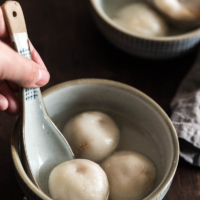
Tang Yuan (Sweet Rice Balls with Peanut Butter Filling)
Learn how to make the best Tang Yuan with a runny filling that will melt in your mouth.
Servings: 24 to 32 rice balls
Ingredients
Filling
- 1/2 cup shelled peanut
- 1/2 cup original peanut butter , unsweetened
- 1 cup caster sugar
- 1/4 cup (4 tablespoons) butter , softened (or lard in room temperature, or melt coconut oil for a vegetarian option) (*footnote 1)
Dough
- 2 cups (250 grams) glutinous rice flour (*footnote 2)
- 1 cup warm water
Instructions
Peanut butter filling
- Spread peanuts in a pan and heat over medium heat on stove. When the pan turns warm, turn to medium low heat. Shake the pan occasionally for even cooking. Toast until the peanuts turn golden but not darkly browned. Alternatively, you can roast the peanuts in 350 F oven for 8 to 15 minutes, or until the surface turns golden. Shake the pan occasionally during baking.
- Ground the peanuts in batches by using a coffee grinder, in a mini food processor, or by using a mortar and pestle until finely grounded, but not into powder. You can leave the pieces a bit larger if you want a chewy texture. Transfer to a bowl. Add peanut butter, sugar and coconut oil. Stir to mix well. Transfer to fridge to harden for about 30 minutes or longer, until it’s possible to scoop out the filling and shape it. If you leave the filling in the fridge for a longer time, it will harden even more and might be a bit difficult to shape. If this is the case, place the filling in room temperature for 5 minutes to let it soften a bit before shaping.
- Use a small spoon to scoop about 1 teaspoon to 1 and 1/2 teaspoon of filling. Shape it quickly into a ball, and place on a small tray or in a container.
- Transfer the peanut butter balls into the freezer while making the dough.
Dough
- Add glutinous rice flour in a big bowl. Slowly add warm water and whisk with a pair of chopsticks (or a spatula). When the water is fully absorbed, use your hands to press and work it into a dough. If the dough is too sticky, add more glutinous rice flour, 1 tablespoon at a time, and keep kneading the dough. Unlike wheat flour dough, rice flour dough does not require a lot of kneading, so it is done once the dough is shaped. Transfer the dough to a big bowl and cover with plastic wrap or a clean wet towel, to prevent it from drying out.
Wrap
- Divide the dough into 4 equal pieces. Shape each piece into a round ball. Work on one dough ball at a time and return the three dough balls back into the large bowl, then cover with plastic wrap.
- Roll the dough ball into a long even strip. Cut to 8 pieces. Roll into small balls.
- Work on the dough balls one by one. Flatten the dough into a round disk that has a dent in the center. Place the filling in the center of the dough. Seal the filling carefully by wrapping and spreading the dough. When you cannot see the filling anymore, roll the dough into a round ball by using both hands.
- If you find the dumpling is too difficult to seal, knead the rest dough balls back together into one big dough ball again, cut into 5 pieces to 6 pieces and try again. It is very important to wrap and seal the dough tightly, so the dumplings won’t fall apart during cooking.
- The filling will become soft if placed in room temperature for too long and become very difficult to wrap, especially if you’re using coconut oil. I suggest you to take out a few filling balls at a time to work with, and store the rest in the freezer.
- Work on the rest of the dough balls using the same method.
- Now you can cook the rice balls or freeze them for later.
Cook
- Bring a pot of water to a boil. Carefully add the number of rice balls you plan to serve. Cook and stir occasionally until the rice balls float on top and the skins look translucent.
- Immediately transfer the rice balls to small serving bowls with just enough boiling water to cover them. We usually eat the rice balls with some boiling water. If it’s not sweet enough for you, add a few drops of honey or osmanthus syrup into the boiling water to sweeten it.
Store
- Place leftover filling in a ziplock bag, squeeze out as much as air as possible, and seal. Store in the fridge for 1 week or in the freezer for up to 3 months.
- To store the raw tang yuan, place them on a tray, 1 finger apart, and cover with a plastic wrap. Freeze until completely frozen. Transfer to a ziplock bag or airtight container, store in the freezer for 2 to 3 months.
- Note, you should always cook the amount of tang yuan you plan to serve and eat them while they’re warm, soon after cooking. Always store the extra tang yuan in the raw form in freezer.
Notes
- If you do not follow a vegan or vegetarian diet, I recommend that you use butter or lard instead of coconut oil. The filling will be easier to handle and won’t melt too fast when you start wrapping.
- Glutenous rice is also called sticky rice. Note, despite its name, the rice flour is gluten-free.